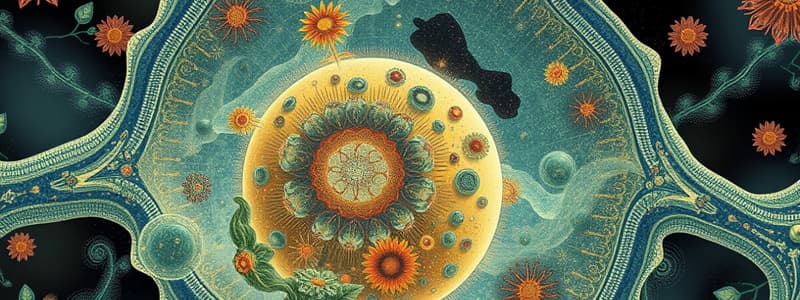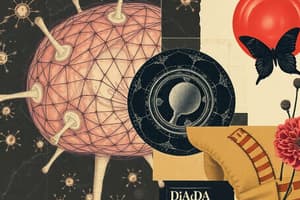Podcast
Questions and Answers
What is the primary function of microtubules in eukaryotic cells?
What is the primary function of microtubules in eukaryotic cells?
- To maintain cell shape and regulate cellular traffic (correct)
- To anchor organelles in the cytoplasm
- To form a rigid cell wall around the cell
- To provide structural support through a dense network
What are receptor proteins primarily responsible for?
What are receptor proteins primarily responsible for?
- Recognizing specific molecules for binding (correct)
- Housing the genetic material of the cell
- Maintaining cellular shape and structure
- Transporting molecules across the cell membrane
Which component of the cytoskeleton is known for providing strength to skin cells?
Which component of the cytoskeleton is known for providing strength to skin cells?
- Microtubules, which are long and hollow
- Microfilaments composed of actin
- Intermediate filaments made of fibrous polypeptides (correct)
- Motor molecules that facilitate movement
What role does the cytoplasm play in a cell?
What role does the cytoplasm play in a cell?
Which statement is true regarding the cell wall of plant cells?
Which statement is true regarding the cell wall of plant cells?
What is a characteristic feature of motor molecules in relation to microfilaments?
What is a characteristic feature of motor molecules in relation to microfilaments?
How does the cytoskeleton respond to environmental changes?
How does the cytoskeleton respond to environmental changes?
What distinguishes the cell walls of bacteria from those of plants?
What distinguishes the cell walls of bacteria from those of plants?
Which scientist is credited with inventing the first primitive microscope?
Which scientist is credited with inventing the first primitive microscope?
What theory did Francesco Redi famously disprove?
What theory did Francesco Redi famously disprove?
What is the primary function of channel proteins in the cell membrane?
What is the primary function of channel proteins in the cell membrane?
Which component of the cell theory states that all living organisms are composed of cells?
Which component of the cell theory states that all living organisms are composed of cells?
What is the structural feature of the plasma membrane that determines its selectively permeable nature?
What is the structural feature of the plasma membrane that determines its selectively permeable nature?
Which part of the phospholipid molecule is hydrophilic?
Which part of the phospholipid molecule is hydrophilic?
Which of the following functions is associated with carrier proteins in the cell membrane?
Which of the following functions is associated with carrier proteins in the cell membrane?
Which part of the cell theory was introduced by Rudolf Virchow?
Which part of the cell theory was introduced by Rudolf Virchow?
Flashcards are hidden until you start studying
Study Notes
Overview of Cell Theory
- Aristotle introduced the spontaneous generation theory, suggesting life could arise from non-living matter.
- Homeostasis is the ability of cells to maintain internal balance amid changing external conditions.
- Cells, especially immune cells, employ membranes for protection against pathogens.
Historical Developments in Cell Theory
- Zacharias Janssen created the first primitive microscope, enabling observation of tiny life forms.
- Robert Hooke first identified and named cells by examining cork under a microscope.
- Francesco Redi conducted experiments disproving spontaneous generation by demonstrating that maggots originate from flies, not decaying meat.
- Anton Van Leeuwenhoek crafted his own microscope, observing single-celled organisms for the first time.
- Matthias Schleiden proposed that all plants consist of cells, marking a fundamental unit of life.
- Theodor Schwann extended this concept to animals, affirming that all living organisms are composed of one or more cells.
- Rudolf Virchow introduced the idea that all cells come from preexisting cells, completing the cell theory.
Components of the Cell
Plasma Membrane
- Composed mainly of phospholipids forming a phospholipid bilayer; this creates a selective barrier.
- Polar phosphate "heads" face outward while nonpolar fatty acid "tails" face inward.
- Fluid mosaic model describes the membrane's structure with embedded proteins, carbohydrates, and cholesterol.
- Key protein types:
- Channel Proteins: Form openings for specific substances to cross the membrane.
- Carrier Proteins: Change shape to transport substances across the membrane.
- Cell Recognition Proteins: Identify pathogens and initiate immune responses.
- Receptor Proteins: Bind specific molecules to trigger cellular responses.
Cytoskeleton
- A network of protein filaments providing structural support from the nucleus to the plasma membrane.
- Composed of three main components:
- Microtubules: Made of alpha- and beta-tubulin, they maintain cell shape and facilitate chromosome movement during division.
- Microfilaments: Comprised of actin, they form a dense structure that supports shape and movement.
- Intermediate Filaments: Made of various proteins and provide mechanical strength; keratin reinforces the strength in skin cells.
- The cytoskeleton is dynamic, adapting to internal and external changes.
Cytoplasm
- A semi-fluid solution called cytosol, containing water, inorganic, and organic molecules.
- Provides a medium for organelles and cellular components.
Cell Wall
- A rigid layer surrounding most prokaryotic cells (e.g., bacteria, archaea).
- Bacterial cell walls contain peptidoglycan; plant cell walls are primarily cellulose; fungal cell walls consist of chitin.
- Maintains cell shape and prevents excessive water absorption, protecting cells from bursting.
Studying That Suits You
Use AI to generate personalized quizzes and flashcards to suit your learning preferences.




